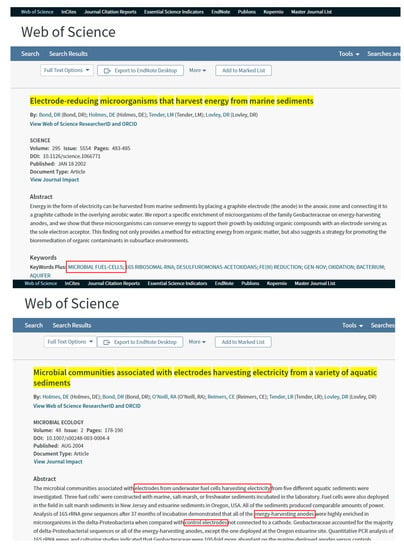Thank you for the comments. It is a great honor that our work has attracted this attention, and we would like to share our ideas and discuss with the commenter.
“Bioelectrochemical systems for groundwater remediation” is a multiple subject related to geology, hydrology, chemistry, microbiology, electrochemistry, geological engineering, and so on. To reveal the past, the development and the research front of this subject comprehensively, a relatively large number of references is needed. In order to collect as many as possible of the related references, the authors used the common searching method in the paper [1] instead of a searching method which might narrow down the searching results. We tried a similar searching method to the one the commenter mentioned at the beginning of our study, and only about 160 papers were detected, which was considered to not fully cover the study subject, and a lot of related and meaningful references were missed.
The commenter mentioned that some references (such as [2,3]) without searching words in their ‘front page’, are not related to “bioelectrochemical systems for groundwater remediation”, and that the top-10 cited papers were not related to “bioelectrochemical systems for groundwater remediation” for the same reason. The truth is that they could be found in the paper’s abstract or keywords (Figure 1). Moreover, these papers, especially the most-cited, could be considered as the research foundation of the study of “bioelectrochemical systems for groundwater remediation”, and the relationship of these papers (published and cited) is clearly revealed by the network maps conducted by CITESPACE. For instance, Wu et al. [4] and Vrionis et al. [5] conducted infield site studies using organic matter (acetate and ethanol) as electron donors to stimulate the growth of metal-reducing microorganisms (Geobacter species), Rooney-Varga et al. [6] found significant increase in Geobacteraceae within the zone of benzene degradation sediments, Reguera et al. [7] found that electrons transferred from the cell surface of Geobacter sulfurreducens to the surface of Fe(III) oxides while the pili of cell served as biological nanowires, and Lovley et al. [8] systematically summarized the environmental significance of Fe(III)- and Mn(IV)-reducing microorganisms. “The emphasis of the research mentioned above—such as the bacterial community structure during in-situ bioremediation, the geochemical heterogeneity in the bioremediation field site, and the electron transfer via microbial nanowires during Fe(III) reduction—are a sort of unity of microbiology, biochemistry, and hydrology, and could be considered as the infancy of the research of BESs for groundwater remediation” [1]. This has been fully discussed in our paper. Besides, the commenter mentioned that some papers (such as article by Holmes et al [9]) could not be found by the searching strategy in our paper, that is because these papers are the references of the retrieved papers, and they are detected by CITESPACE but not searched through WOS directly.

Figure 1.
Words that proved the papers are closely related to our study subject.
We would like to thank the commenter again for the comments on this article and respect the commenter’s spirit of careful study, and we will be more rigorous and consider multiple searching methods while conducting scientometric research in future.
Author Contributions
W.L., X.C., L.X., Z.L. and X.X. explained the questions and revised the reply. All authors have read and agreed to the published version of the manuscript.
Funding
This paper received no external funding.
Conflicts of Interest
The authors declare no conflict of interest.
References
- Li, W.; Chen, X.; Xie, L.; Liu, Z.; Xiong, X. Bioelectrochemical systems for groundwater remediation: The development trend and research front revealed by bibliometric analysis. Water 2019, 11, 1532. [Google Scholar] [CrossRef]
- Bond, D.R.; Holmes, D.E.; Tender, L.M.; Lovley, D.R. Electrode-reducing microorganisms that harvest energy from marine sediments. Science 2002, 295, 483–485. [Google Scholar] [CrossRef] [PubMed]
- Holmes, D.E.; Bond, D.R.; O’Neill, R.A.; Reimers, C.E.; Tender, L.R.; Lovley, D.R. Microbial communities associated with electrodes harvesting electricity from a variety of aquatic sediments. Microb. Ecol. 2004, 48, 178–190. [Google Scholar] [CrossRef] [PubMed]
- Wu, W.M.; Carley, J.; Gentry, T.; Ginder-Vogel, M.A.; Fienen, M.; Mehlhorn, T.; Yan, H.; Caroll, S.; Pace, M.N.; Nyman, J.; et al. Pilot-scale in situ bioremedation of uranium in a highly contaminated aquifer. Reduction of U(VI) and geochemical control of U(VI) bioavailability. Environ. Sci. Technol. 2006, 40, 3986–3995. [Google Scholar] [CrossRef] [PubMed]
- Vrionis, H.A.; Anderson, R.T.; Ortiz-Bernad, I.; O’Neill, K.R.; Resch, C.T.; Peacock, A.D.; Dayvault, R.; White, D.C.; Long, P.E.; Lovley, D.R. Microbiological and geochemical heterogeneity in an in situ uranium bioremediation field site ness. Appl. Environ. Microbiol. 2005, 71, 6308–6318. [Google Scholar] [CrossRef] [PubMed]
- Rooney-Varga, J.N.; Anderson, R.T.; Fraga, J.L.; Ringelberg, D.; Lovley, D.R. Microbial communities associated with anaerobic benzene degradation in a petroleum-contaminated aquifer. Appl. Environ. Microbiol. 1999, 65, 3056–3063. [Google Scholar] [CrossRef] [PubMed]
- Reguera, G.; McCarthy, K.D.; Mehta, T.; Nicoll, J.S.; Tuominen, M.T.; Lovley, D.R. Extracellular electron transfer via microbial nanowires. Nature 2005, 435, 1098–1101. [Google Scholar] [CrossRef] [PubMed]
- Lovley, D.R.; Holmes, D.E.; Nevin, K.P. Dissimilatory Fe(III) and Mn(IV) Reduction. Adv. Microb. Physiol. 2004, 49, 219–286. [Google Scholar] [PubMed]
- Holmes, D.E.; Finneran, K.T.; O’Neil, R.A.; Lovley, D.R. Enrichment of members of the family Geobacteraceae associated with stimulation of dissimilatory metal reduction in uranium-contaminated aquifer sediments. Appl. Environ. Microbiol. 2002, 68, 2300–2306. [Google Scholar] [CrossRef] [PubMed]
© 2020 by the authors. Licensee MDPI, Basel, Switzerland. This article is an open access article distributed under the terms and conditions of the Creative Commons Attribution (CC BY) license (http://creativecommons.org/licenses/by/4.0/).